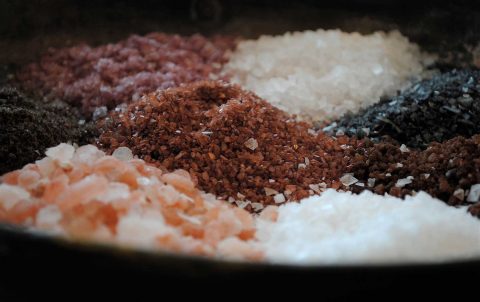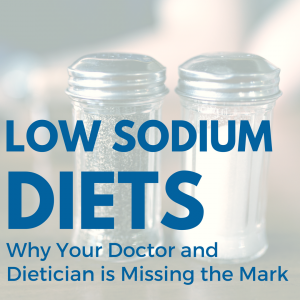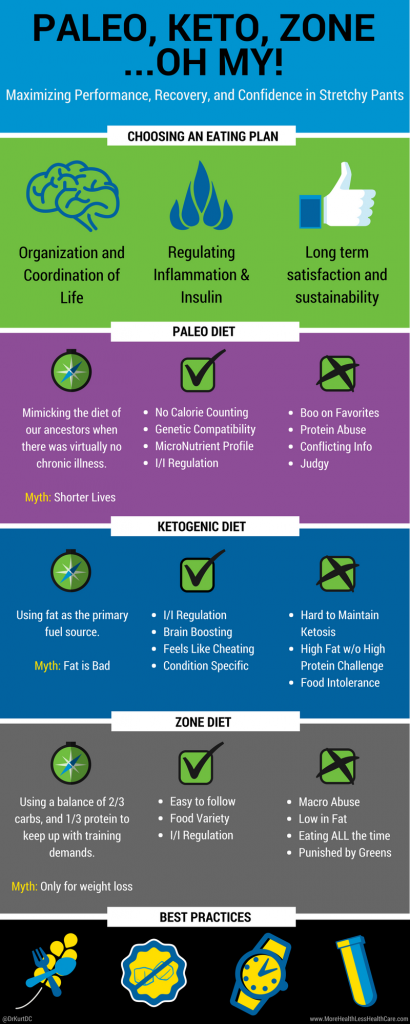
If you are being treated for high blood pressure, I’m sure you’ve been told to watch your sodium intake. The traditional medical theory is that since you consume too much sodium, your body is so defective that it doesn’t know what to do with it, so it holds onto the sodium. And if you’re holding onto too much sodium, you will then unfortunately hold onto fluid. And if you are holding onto fluid, this makes your heart work harder, thus raising blood pressure. And if you don’t get that lowered, you’re going to die…like yesterday.
This all sounds good and logical…except that it isn’t. Well not exactly. Yes, sodium retention will create fluid retention which can create blood pressure elevation. But your body has too many checks and balances to just let sodium hang around from dietary intake.
can create blood pressure elevation. But your body has too many checks and balances to just let sodium hang around from dietary intake.
The part that contradicts the notion that you need a low sodium diet is that your body never does stupid stuff. If your body is holding onto sodium to raise blood pressure, then there’s a very important reason. And that reason is because you are attempting to escape something that is potentially or perceived as dangerous (whether you are aware of it or not).
Sodium is a major player in the communication signals from the adrenals to the kidneys. If you’re in danger, those signals will create the retention of sodium so that there’s an end game expression of an increase in blood pressure. If you cannot get your blood pressure elevated to pump blood filled with all the nutrients and hormones necessary to engage muscle and nervous system activity to escape the danger, you’re done…like yesterday.
The general population experiences daily dangers from sitting too much, adverse childhood experiences that are unresolved, the Standard America Diet (not just salt intake), and staying employed at a job that is hated to earn money to impress people that aren’t liked, to buy stuff that isn’t even wanted. Just because you don’t have an immediate deadline doesn’t mean you aren’t stressed.
All these stimulli will contribute to sodium retention but I would argue that going on a low sodium diet doesn’t fix much from a nutritional standpoint. And if it does help, it’s not that you are consuming less sodium. You are consuming less foods that create an adaptation that requires you to retain sodium.
Most ‘high sodium’ foods listed are going to be the ones that are also high glycemic and insulin spiking foods. The greater the sugar load, the greater the insulin response.
Deli meats and pickles could be listed as high sodium foods. But more often than not, those types of foods are dressed up with some sort of bread (low fat, high sodium, high glycemic impact). Spaghetti sauce is often listed as a high sodium food (also high glycemic). But what gets paired with sauce is often pasta (low fat, high sodium, high glycemic impact). And most of your grain based products will also be listed as high sodium foods (as well as low fat and high glycemic impact). But it’s these wheat and grains that are the worst offenders because of their sugar and insulin response, regardless of sodium content.
Therein lies the bigger issue.
Lowering blood sugar is only one of the vast sea of functions insulin carries. For the sake of this argument, another role is to store excess nutrients. The more insulin has to be released, especially in response to sugar (grains) loads, the more toxic it becomes. It’s like a an email inbox. When email was new and exciting (circa 1997), you allowed all messages into your inbox. You opened all of them, read them, and forwarded them. You didn’t even know there was a junk box or spam folder.
Fast forward 20 years, you dread opening your email inbox for fear of all the junk you have to sift through. The more insulin is released into your body, the more your cells get tired of listening to it and turn around and stop listening (delete, delete, delete). Your cells essentially hit the spam and unsubscribe button on insulin’s signals. This is insulin resistance.
But most associate insulin resistance with obesity and diabetes. Remember, insulin has roles in storing all excess nutrients, not just sugar. If that nutrient is magnesium, you won’t utilize it well. Magnesium has roles from muscle relaxation to being involved in hundreds of energy reactions. Hello muscle cramping and fatigue.
Your blood vessels are muscles so if they cannot relax, you have to squeeze the same amount of blood through your body in a hole that just got smaller. Hello blood pressure. The sodium influence is no different.
A little known fact about insulin is that it causes sodium retention. Why would this happen? Since high levels of insulin is toxic (dangerous) to your cells, high levels will actually push you into and stimulate the sympathetic nervous system (fight or flight). This then re-triggers the adrenals, increasing the communication to the kidneys to hold onto sodium to raise blood pressure to help you escape. This also triggers the adrenals to release cortisol to dump stored sugar into your blood stream to have access to rocket fuel to escape the danger. To make sure that energy is available, insulin resistant increases to make sure you escape the next 30 seconds.
But sodium gets blamed. Or should we say framed.
Because sodium is retained, it looks elevated on your blood work. And if something is elevated, that ‘must be the problem.’ If cholesterol is high, it’s a fat problem. If TSH is high, it’s a thyroid problem. If estrogen is elevated, that must be the problem. Again, this all sounds good and logical…except that it isn’t.
If dietary sodium was the culprit, then there would be no need for medications. Remove the sodium and the blood pressure returns to normal. But along with a low sodium diet, medications are often prescribed to combat the issue in addition.
It could be a Beta Blocker: the signal from your adrenals that tells your kidney to hold onto sodium). It could be a diuretic: forcing the loss of water. You start feeling really fatigued but chalk it up to work stress and start loading up on caffeine, another diuretic that also stimulates the adrenals. You feel like crap but your BP looks great and you get kudos from your doctor and dietician because you are watching your sodium intake. “Keep up the good work..now stay on the BP meds forever…and it’s probably good that we add this blood thinner too.”
The more they try and over ride your innate intelligence, the harder your body pushes back. It needs to retain sodium for a reason. It needs to elevate blood pressure for a reason. And the body will will always give you the best chance of survival, even when those intelligent adaptations are trying to be chemically suppressed.
The whole time, they have missed one of the most stressful things in your life, out of control insulin. Why did they miss this? They aren’t looking for it. You have high blood pressure, why would they check for insulin sensitivity?
Creating Insulin Resilience
 Regardless of your health condition or diagnosis, if there is an overburdened insulin load, the success of you improving that condition without addressing insulin will be a steep, uphill battle.
Regardless of your health condition or diagnosis, if there is an overburdened insulin load, the success of you improving that condition without addressing insulin will be a steep, uphill battle.
How do you know if you have out of control insulin? Just test for it. Blood glucose and A1C can give an indication of insulin resistance but when you add a fasting insulin with those other 2 factors, you get a better story. The problem is that most labs won’t flag fasting insulin high until a value of 25 uIU/ml. If you want real success, that number should be between 3-8.
The next step will be figuring out where the biggest sources of sugar load are coming from. I’ve already picked on the wheat and grains but I would argue the next biggest impact, if not the biggest is from our healthcare system. There are 390 medications that will affect blood sugar, with the overwhelming majority elevating it. This can signify another uphill battle.
I don’t recommend going off meds cold turkey, especially if you don’t have a plan in place to create health that creates less need for meds. With that said, diet is often the best place to start as it’s the easiest to control. And if you’re confused about where to start, there are 3 diets that I think are great starting points.
Paleo
Paleo’s premise is to mimic the diet of our hunter-gatherer ancestors who virtually had zero chronic illness. They had other things to worry about in regards to shelter, injury, saber tooth tigers, and infection that could be immediately life threatening.
This is the human’s diet consumed before industrialization. As a result, this takes away grains and dairy, 2 of the biggest insulin responding foods.
For most, this is a great plan since there’s no calorie counting, it optimizes micronutrient intake, and regulates insulin and inflammation.
The hard part for most is that it’s a big change so it can be intimidating. But if we’re not challenged, we don’t grow and improve. I’ve also seen it become a version of Atkins where everything is served with bacon…even bacon. And the paleo diet can get judgy in the community. People treat it more like a religion and if you’re eating something not approved (by their standards), you’re sinning and therefore go to Paleolithic purgatory, awaiting judgement.
The book I recommend the most to get people started is Dianne Sanfilippo’s ‘Practical Paleo.‘
Keto
The ketogenic diet may be the best at regulating insulin’s response since it’s a high fat diet, or rather a diet that promotes burning fat as fuel opposed to sugar. A great thing about the ketogenic diet is that it is being used for condition specific treatments like severe seizures. If it’s great for severe conditions like that, then there are great benefits for less advanced illness as well.
Ketosis is the process of using fat as fuel opposed to sugar and also being used for high performance executive function as well as ultra distance athletes.
The frustration with the ketogenic diet is that it can be difficult to maintain ketosis. This high fat intake is often paired with some fasting. Another knock against it is that it’s hard to eat high fat without eating high protein. Feedback from some close relationships say they feel like they are drowning everything they eat with oil.
Zone
The zone diet is a third option great at regulating insulin and inflammation. It’s a balance of fat, carbs and proteins, laid out in blocks of food based on your desire to lose weight, gain mass, or just have enough fuel to maintain your training schedule. This diet may be the most popular among CrossFit enthusiasts. Out of the three, this has the most room for variety of foods since you’re counting macros (fats, carbs, proteins).
The problem with that macro counting is that you can 50 grams of carbs from a donut or 50 grams of carbs from broccoli. It’s an easier system to abuse, though it’s not recommended by the developers. A frustration from participants is that they feel they are constantly eating. Sometimes they aren’t hungry but it calls for another full meal.
Best Practices
While all 3 are fantastic alone, I think you can be successful taking the best practices from all 3. I run a program in my office that takes paleo food lists, puts it in a zone type eating plan, while helping you create and maintain ketosis. Over 5-10 weeks, the average person loses 27 pounds, loses 18 inches, reduced triglycerides 40%, reduces fasting blood sugar 19%, and drops blood pressure by 30 points.
I wouldn’t say it’s for everyone but to those that are looking to lose over 20 pounds that aren’t the most physically active. But in case of nutritional change, look for the eating plan that will regulate insulin. To please your doctor, you can create a lower sodium died that is also low in insulin spiking. But chances are, this will be the opposite of what your doctor and dietician endorse since it will remove the USDA recommended servings for grains and dairy. It can be intimidating to know where to start. If you need help, you know how to find me.


2 Comments